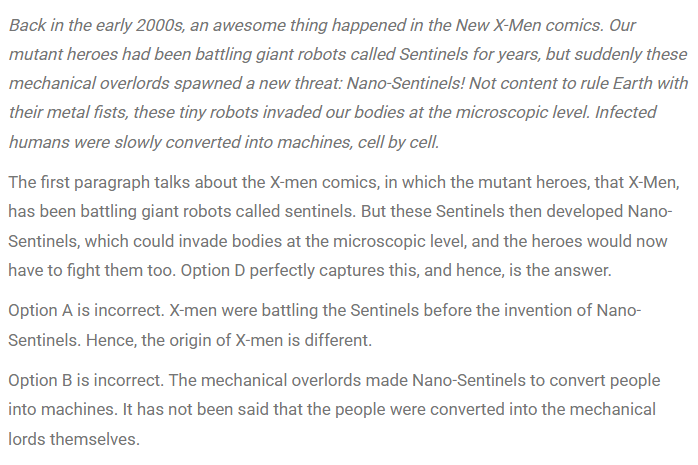CAT RC Questions | CAT RC Based on Natural Science questions
FundaMakers is the Best CAT Online Coaching In India. Now prepare for CAT anytime with FundaMakers. We provide well-ordered syllabus coverage for both offline and online CAT preparation batches. FundaMakers brings to you the power-packed, well-structured CAT previous year question bank with more than 4000+ CAT Past Year questions. In the VARC section, one of the most frequently asked questions is from the topic- Reading Comprehension. Reading Comprehension turns out to be an important part of the VARC section from which over 60-70% of the questions are based on RC in the CAT Exam.
FundaMakers as a team has taken a painstaking step to bring you all the video solutions of the Reading Comprehension asked in the Previous Year CAT exam. CAT question bank offered by FundaMakers is a power-packed topic-wise compilation of the entire CAT previous year questions. Questions from the Reading Comprehension topic are some of the most scoring questions in the VARC section. To maximize your CAT score make use of FundaMakers CAT Question Bank. “Questions from CAT previous years” examination papers have been incorporated. Let’s get started with CAT Past Year Reading Comprehension Questions.
Comprehension
The passage below is accompanied by a set of questions. Choose the best answer to each question.
Back in the early 2000s, an awesome thing happened in the New X-Men comics. Our mutant heroes had been battling giant robots called Sentinels for years, but suddenly these mechanical overlords spawned a new threat: Nano-Sentinels! Not content to rule Earth with their metal fists, these tiny robots invaded our bodies at the microscopic level. Infected humans were slowly converted into machines, cell by cell.
Now, a new wave of extremely odd robots is making at least part of the Nano-Sentinels story come true. Using exotic fabrication materials like squishy hydrogels and elastic polymers, researchers are making autonomous devices that are often tiny and that could turn out to be more powerful than an army of Terminators. Some are 1-centimetre blobs that can skate over water. Others are flat sheets that can roll themselves into tubes, or matchstick-sized plastic coils that act as powerful muscles. No, they won’t be invading our bodies and turning us into Sentinels – which I personally find a little disappointing – but some of them could one day swim through our bloodstream to heal us. They could also clean up pollutants in water or fold themselves into different kinds of vehicles for us to drive. . . .
Unlike a traditional robot, which is made of mechanical parts, these new kinds of robots are made from molecular parts. The principle is the same: both are devices that can move around and do things independently. But a robot made from smart materials might be nothing more than a pink drop of hydrogel. Instead of gears and wires, it’s assembled from two kinds of molecules – some that love water and some that avoid it – which interact to allow the bot to skate on top of a pond.
Sometimes these materials are used to enhance more conventional robots. One team of researchers, for example, has developed a different kind of hydrogel that becomes sticky when exposed to a low-voltage zap of electricity and then stops being sticky when the electricity is switched off. This putty-like gel can be pasted right onto the feet or wheels of a robot. When the robot wants to climb a sheer wall or scoot across the ceiling, it can activate its sticky feet with a few volts. Once it is back on a flat surface again, the robot turns off the adhesive like a light switch.
Robots that are wholly or partly made of gloop aren’t the future that I was promised in science fiction. But it’s definitely the future I want. I’m especially keen on the nanometre-scale “soft robots” that could one day swim through our bodies. Metin Sitti, a director at the Max Planck Institute for Intelligent Systems in Germany, worked with colleagues to prototype these tiny, synthetic beasts using various stretchy materials, such as simple rubber, and seeding them with magnetic microparticles. They are assembled into a finished shape by applying magnetic fields. The results look like flowers or geometric shapes made from Tinkertoy ball and stick modelling kits. They’re guided through tubes of fluid using magnets, and can even stop and cling to the sides of a tube.
CAT/2021.3
Question . 33
Which one of the following statements best captures the sense of the first paragraph?
Explanatory Answer
Method of solving this CAT RC Question from RC Based on Natural Science question
Correct Option: D

Hey!
Worried about IIM calls due to your marks in 10th,12th, and Graduation?
Don't worry! Know your chances of getting an IIM Call based on your profile with our:-
Profile Professor: https://fundamakers.com/profile-professor/

5 Must- NOT-Dos during CAT Preparation.
- Do not treat CAT as 'Everything'.
- Do not quit your job for CAT exam preparation.
- Learning till The Eleventh hour instead of doing proper revision.
- Not checking the syllabus thoroughly.
- Piling up multiple books.
Click To Read:- Common mistakes made by CAT aspirants during preparation.
FundaMakers- Best Online and Offline CAT Online Preparation Institute in India
For any CAT Preparation related query, reach out to us at 9598333344.